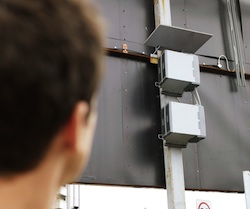Nokia Solutions and Networks has introduced a new small cells solution that is not only the smallest in the industry in terms of size and weight, but also comes with the baseband processing power and capacity usually seen in macrocells.
The new Flexi Zone LTE microcell and picocell base stations – which weigh only 5kg, compared to other industry small cells, which typically weigh between 15-17kg – come with Bluetooth capabilities to enable remote access and, ordering up to 5W of output power, feature a built-in GPS module and 1588v2 synchronisation.
However, what is most interesting is that they offer macro-level processing power thanks to NSN’s customised “System on a Chip” technology. This enables the small cells to run the exact same software as the macrocell base stations, which makes it much easier to integrate into HetNets.
“We’ve worked very hard with our chipset manufacturer [a major player in the industry] to combine different chipsets on the same silicon [in the same small cell unit],” Stéphane Daeuble, Head of Small Cell & Flexi Zone Product Marketing at NSN tells Mobile Europe.
“This means we can make the right chipset at the right place to give us the processing power we need, and we’re using software code that has been efficiently optimised and is already running on many LTE networks so that we can run the same code on the macrocell and the small cell.”
Yet NSN’s game plan is not just to have the smallest solution on the market, but to enable operators to quickly upgrade their macrocell and small cell networks together to LTE-Advance, as well as to create “hotzones” – numerous hotspots linked up together.
“It’s like putting cloud computing to [small cells]. It’s a significant paradigm shift,” said Daeuble. “Small cells cannot be just a subset of a macro network. If the HetNet is tightly integrated, it is more effective and costs less money.”
This follows on from NSN’s Flexi Zone small cells clustering concept, launched in 2011, which enables operators to control and upgrade a cluster of small cells without manual upgrades, ripping out and replacing equipment as well as other street level interference problems.
“When you install a small cell on a lamppost, you need to connect it to a bucket truck, then hook it up to the cable. With Bluetooth, the engineer can install it remotely from the ground and the bucket truck can start deploying the next small cell,” explained Daeuble.
“Also, you don’t need another box for the GPS antenna, the GPS is integrated into the small cell. This means you can fit more small cells onto the same lightpoles, and poles are much cheaper to install small cells on than walls.”
NSN says a new Flexi Zone controller will be released next year that will turn the clusters of small cell hotspots into hotzones. In addition to dealing to street level problems, the controller also makes all the picocells and microcells appear on the network as a single eNodeB, which simplifies network management.
“Small cells are not a problem in the home as they cover an area that is only [at most] two metres [which] doesn’t affect the macro, but you can’t do that in a big city,” said Daeuble.
“You can have small cells without macro parity, but you’re going to spend lots of money going back into the macro tweaking the network and moving antennas. It’s going to get quite complicated. Operators cannot afford to spend the same time optimising small cells as they spend with the macro network. The business case is not going to fly.”
According to NSN, using the small cells cluster approach together with its new small cells solution will help operators to save 40 percent opex costs from using lightpoles instead of urban building walls; 10-20 percent savings due to not having to use multiple software between the small cells and the macro network; a 50-70 percent opex saving while installing the small cells as you won’t need to block off the road; and being able to upgrade hotspots to become hotzones remotely in the future will offer up to 80 percent savings.
The new solution will be available in early 2014.



